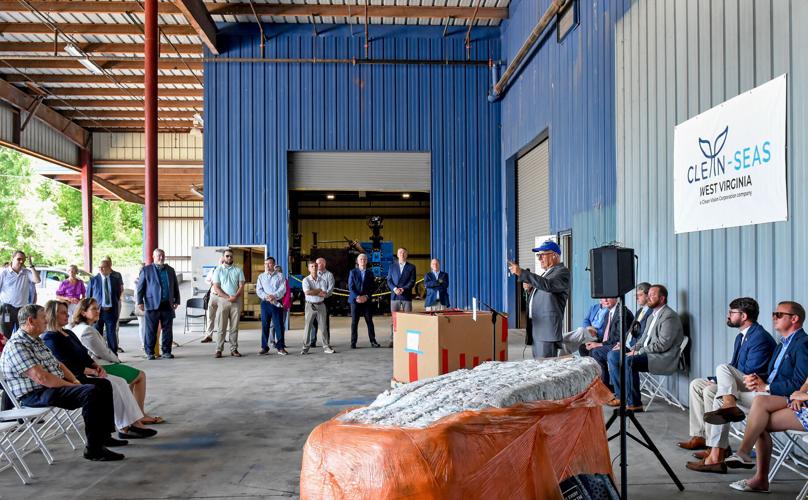CHARLESTON ├█┴─Í▒▓ąö A new plastic-to-fuel plant coming to the Upper Kanawha Valley promises jobs and innovation ├█┴─Í▒▓ąö but critics say the facility could do more harm than good. West Virginia, a subsidiary of , hosted a launch party for its newest facility, located at the former 84 Lumber location at 2700 E. Dupont Ave., in Quincy, near Belle.
The facility, which is the first pyrolysis recycling facility in the United States, will use high-heat chemical recycling to convert plastic waste into fuel ├█┴─Í▒▓ąö part of a $65 million project the company says will initially create 40 jobs in the Kanawha Valley.
The location will allow Clean-Seas to use rail and river transport to bring plastic feedstock, the plastic material that Clean-Seas uses as the input for their recycling process, into the facility, according to CEO Dan Bates.
The site is expected to be the first Plastic Conversion Network facility in the United States. News releases from the company say the project will reduce plastic waste by converting it into ├█┴─Í▒▓ąťusable materials.├█┴─Í▒▓ąŁ
Once fully operational ├█┴─Í▒▓ąö projected for the fourth quarter of 2025 ├█┴─Í▒▓ąö the company estimates the Quincy site will be capable of processing 50 tons of plastic waste per day, converting it into ├█┴─Í▒▓ąťclean hydrogen and other high-value fuels.├█┴─Í▒▓ąŁ Additional jobs could be expected as the plant scales up to potentially 200 tons per day.
Bates also announced that additional facilities are being planned for Arizona, Michigan and Ohio, as well as additional locations internationally.
Clean-Seas says its advanced recycling technique is designed not only to divert plastic waste from landfills and incinerators but also to contribute to economic revitalization in the Kanawha Valley. However, environmental stakeholders have accused companies using this method of ├█┴─Í▒▓ąťgreenwashing,├█┴─Í▒▓ąŁ arguing it contributes to more pollution.
Facility details and timeline
Site preparation began in March, retrofitting a 60,000-square-foot facility to house pre-processing equipment, storage tanks, an on-site chemical analysis lab and administrative offices.
The first pyrolysis reactor ├█┴─Í▒▓ąö a smaller training, research and evaluation unit provided by American Renewable Technology Inc. ├█┴─Í▒▓ąö arrived from California in June to test and refine Clean-Seas├█┴─Í▒▓ąÖ process, ensure safety protocols and train the local workforce.
The project has received $25 million in public and private support, including a $15 million bridge loan backed by the West Virginia Economic Development Authority and financed through Huntington National Bank in January 2024.
Clean-Seas has exclusive global rights to the advanced pyrolysis technology being deployed in Quincy. UPS Industrial Services and Middough Engineering are overseeing engineering, procurement and construction.
Clean-Seas says its process converts plastic waste into clean feedstocks, which raw materials used to make a useful product in an industrial process, used by petrochemical companies for the manufacturing of new plastic products.
How the process works
Here is the pyrolysis process, according to Clean Vision Corp. CEO Dan Bates:
- The process starts with plastic waste. Initially, the company will handle post-industrial plastic from manufacturers and will expand to include post-consumer plastic (household waste).
- The plastic is heated under pressure in the absence of oxygen (no combustion or flames), which breaks it down into three components: solids, liquids and gases.
- The gases produced are recycled to keep the burners hot, making the process largely self-sustaining after it starts.
- The liquid output is an oil, which is sold to petrochemical companies.
Bates said the no-combustion process is designed to avoid emissions, and the company aims to comply with strict environmental standards.
Environmental implications and concerns
Team members from , an organization with more than 1.5 million parents working to reduce air and climate pollution, cited concerns about this recycling method in a June 2024 .
In a June 30 email, Candi Hurst, a field organizer for MCAF in West Virginia, expressed concern about Clean-Seas├█┴─Í▒▓ąÖ use of pyrolysis, saying it was ├█┴─Í▒▓ąťburn[ing] plastic trash.├█┴─Í▒▓ąŁ
Hurst went on to explain that pyrolysis is often ├█┴─Í▒▓ąťgreenwashed,├█┴─Í▒▓ąŁ or inaccurately promoted as economically friendly, as ├█┴─Í▒▓ąťadvanced recycling.├█┴─Í▒▓ąŁ
├█┴─Í▒▓ąťBut it is neither advanced nor recycling,├█┴─Í▒▓ąŁ she said. ├█┴─Í▒▓ąťIt is burning plastic. Burning plastic releases harmful chemicals into the air we breathe. These toxic pollutants have been linked to serious health concerns, including cancer and respiratory illnesses.
├█┴─Í▒▓ąťThe plastic trash is heated and transformed into hazardous air pollution, hazardous waste ash, and heavily-contaminated pyrolysis oils that are used to make dirty fuels.├█┴─Í▒▓ąŁ
Specifically, Hurst states that the heating process generates climate-warming gases and releases toxic pollution that can impact health, including heavy metals and PFAs, or ├█┴─Í▒▓ąťforever plastics.├█┴─Í▒▓ąŁ
├█┴─Í▒▓ąťExposure to this pollution increases the risk of cancer, birth defects, reproductive system damage, developmental issues, cardiovascular problems, respiratory impairment, hormonal irregularities, and neurological problems,├█┴─Í▒▓ąŁ she said.
When asked about ecological concerns, Bates replied, ├█┴─Í▒▓ąťWe are certainly in debate with many of those naysayers [who say] it├█┴─Í▒▓ąÖs a dirty process.├█┴─Í▒▓ąŁ
Bates insists that, if done correctly, there are no emissions. While he acknowledged the toxicity of oil byproducts, he noted that the company intends to ├█┴─Í▒▓ąťdo everything right├█┴─Í▒▓ąŁ in West Virginia to ensure safe handling and minimal risk.
├█┴─Í▒▓ąťWe will comply with all EPA regulations and all the state regulations. We will make sure that everything that we do is as clean as it can possibly be,├█┴─Í▒▓ąŁ he said. ├█┴─Í▒▓ąťWe├█┴─Í▒▓ąÖre setting this factory up with machines and equipment made and certified in California. If you can get this thing certified by the South Coast Air Quality Management District in California, you can get it certified anywhere.├█┴─Í▒▓ąŁ
Neither party├█┴─Í▒▓ąÖs claims about emissions could be verified through the West Virginia Department of Environmental Protection, as the agency has not received any permit applications from Clean-Seas or Clean Vision for operations in Kanawha County.
Terry Fletcher, chief communications officer for WVDEP, said, ├█┴─Í▒▓ąťThe WVDEP is aware of updates to the Clean-Seas website, which indicate potential activity. The agency will be sending staff out to evaluate.├█┴─Í▒▓ąŁ
Bates said the organization has completed multiple permits and is in the process of getting an air quality permit through the Department of Environmental Protection and hope to have that in a couple of months.
A voice for communitiesIn the webinar, members of MCAF WV argued many chemical recycling facilities are being proposed in communities of color and low-income communities that are already overburdened with air pollution and environmental pollution, posing a large environmental justice risk for the communities that they are located in.
Hurst said she├█┴─Í▒▓ąÖd like to see the communities near the facility be made aware of the potential health risks.
├█┴─Í▒▓ąťIt├█┴─Í▒▓ąÖs my hope that community members can have a say about the Clean-Seas facility, which may expose them and their children to some very significant health risks,├█┴─Í▒▓ąŁ she said.
But what health risks exist?
In a , Ren├ęe Sharp and Shannon Goff asserted the plastic industry is ├█┴─Í▒▓ąťdoubling down├█┴─Í▒▓ąŁ on ├█┴─Í▒▓ąťdeceptive recycling claims├█┴─Í▒▓ąŁ by promoting incineration and other toxic methods for end-of-life plastic management under the guises of ├█┴─Í▒▓ąťchemical recycling,├█┴─Í▒▓ąŁ ├█┴─Í▒▓ąťadvanced recycling├█┴─Í▒▓ąŁ and ├█┴─Í▒▓ąťmolecular recycling.├█┴─Í▒▓ąŁ
├█┴─Í▒▓ąťThe truth is these approaches largely fail to recycle plastic,├█┴─Í▒▓ąŁ they wrote. ├█┴─Í▒▓ąťTheir expanded use will only lead to more toxic pollution of our air and water and more plastic waste in landfills and incinerators. Meanwhile, the industry hopes that production of new plastic will continue to grow, unrestricted, because the public├█┴─Í▒▓ąÖs concerns will be eased by this new promise of ├█┴─Í▒▓ąśchemical recycling.├█┴─Í▒▓ąÖ├█┴─Í▒▓ąŁ
Communities where these facilities exist are more likely to be exposed to toxic, cancer-causing chemicals, they said. However, the NRDC also asserts proximate communities could feel the negative effects.
In , the organization wrote that proximity to waste incineration may increase risks of cancer, birth defects, and other adverse health impacts. According to the brief, hazardous waste from ├█┴─Í▒▓ąťchemical recycling├█┴─Í▒▓ąŁ plants is commonly transported across state lines.
├█┴─Í▒▓ąťThis means that many more communities could be impacted in the event of an accident during transit,├█┴─Í▒▓ąŁ the brief states.
Celerah Hewes, also of MCAF WV, said their organization is supporting communities working to ├█┴─Í▒▓ąťdefeat the threat of advanced recycling,├█┴─Í▒▓ąŁ citing facilities in Follansbee, Brooke County, and also in Pennsylvania and Ohio that have been canceled or put on hold.
However, the Upper Kanawha Valley has deep roots in the petrochemical industry.
Belle Mayor Dave Fletcher said, ├█┴─Í▒▓ąťI think it├█┴─Í▒▓ąÖs a great opportunity ... Really, bringing in jobs is something that is needed in the Upper Kanawha Valley. I applaud them for bringing it to this area.├█┴─Í▒▓ąŁ
Mayor Melissa Hill of nearby Chesapeake said she also recognized the need for job creation but noted some of her constituents raised concerns about the new facility polluting the nearby river or air.
├█┴─Í▒▓ąťChemical Valley was the last boon for us,├█┴─Í▒▓ąŁ she said. ├█┴─Í▒▓ąťBut we├█┴─Í▒▓ąÖre stuck between a rock and a hard place because as they try to bring in new opportunities, we have to evaluate the long-term impact.├█┴─Í▒▓ąŁ
Pyrolysis efficacy
As the world grapples with mounting plastic waste, researchers are exploring advanced recycling technologies to curb environmental damage and reduce reliance on fossil fuels.
Clean-Seas├█┴─Í▒▓ąÖ method, pyrolysis, has gained attention for its potential to convert hard-to-recycle plastics into usable raw materials.
A 2023 found that pyrolysis, an advanced recycling method for post-use plastic, can significantly reduce environmental impacts compared to traditional plastic production.
By converting plastic waste into pyrolysis oil ├█┴─Í▒▓ąö a substitute for fossil-based feedstocks ├█┴─Í▒▓ąö this process enables new plastic production with 18├█┴─Í▒▓ąô23% fewer greenhouse gas emissions, and up to 50% reductions when factoring in avoided landfill or incineration. Pyrolysis also cuts fossil energy use by up to 70%, water consumption by over 50%, and reduces solid waste generation by more than 100%, showing promise for managing hard-to-recycle plastics.
However, a separate 2023 from the U.S. Department of Energy├█┴─Í▒▓ąÖs National Renewable Energy Laboratory and published in ├█┴─Í▒▓ąťACS Sustainable Chemistry & Engineering├█┴─Í▒▓ąŁ cautioned that pyrolysis and gasification are energy-intensive and better suited for fuel production than cost-effective plastic recycling.
Researchers found that mechanical recycling has the lowest carbon footprint among current recycling technologies. While chemical recycling shows some promise, the study emphasizes its high environmental and economic costs and suggests that substantial improvements are needed before it can compete sustainably. The findings support broader strategies for reducing environmental impact, such as improving material retention, minimizing energy use, and integrating renewable energy ├█┴─Í▒▓ąö rather than relying solely on emerging chemical recycling methods.
├█┴─Í▒▓ąť├█┴─Í▒▓ąśChemical recycling├█┴─Í▒▓ąÖ is a false solution to our plastic problem,├█┴─Í▒▓ąŁ Sharp and Goff wrote. ├█┴─Í▒▓ąťIt doesn├█┴─Í▒▓ąÖt halt the deluge of plastic waste, and it creates new harms. Policymakers, companies, and the public should not fall for the industry greenwashing and should instead focus on real solutions to the plastics crisis: reducing plastic production and use; switching to more environmentally sound materials; eliminating the most toxic plastics and chemical additives; and building a robust infrastructure for nontoxic plastic reuse/return systems.├█┴─Í▒▓ąŁ




















